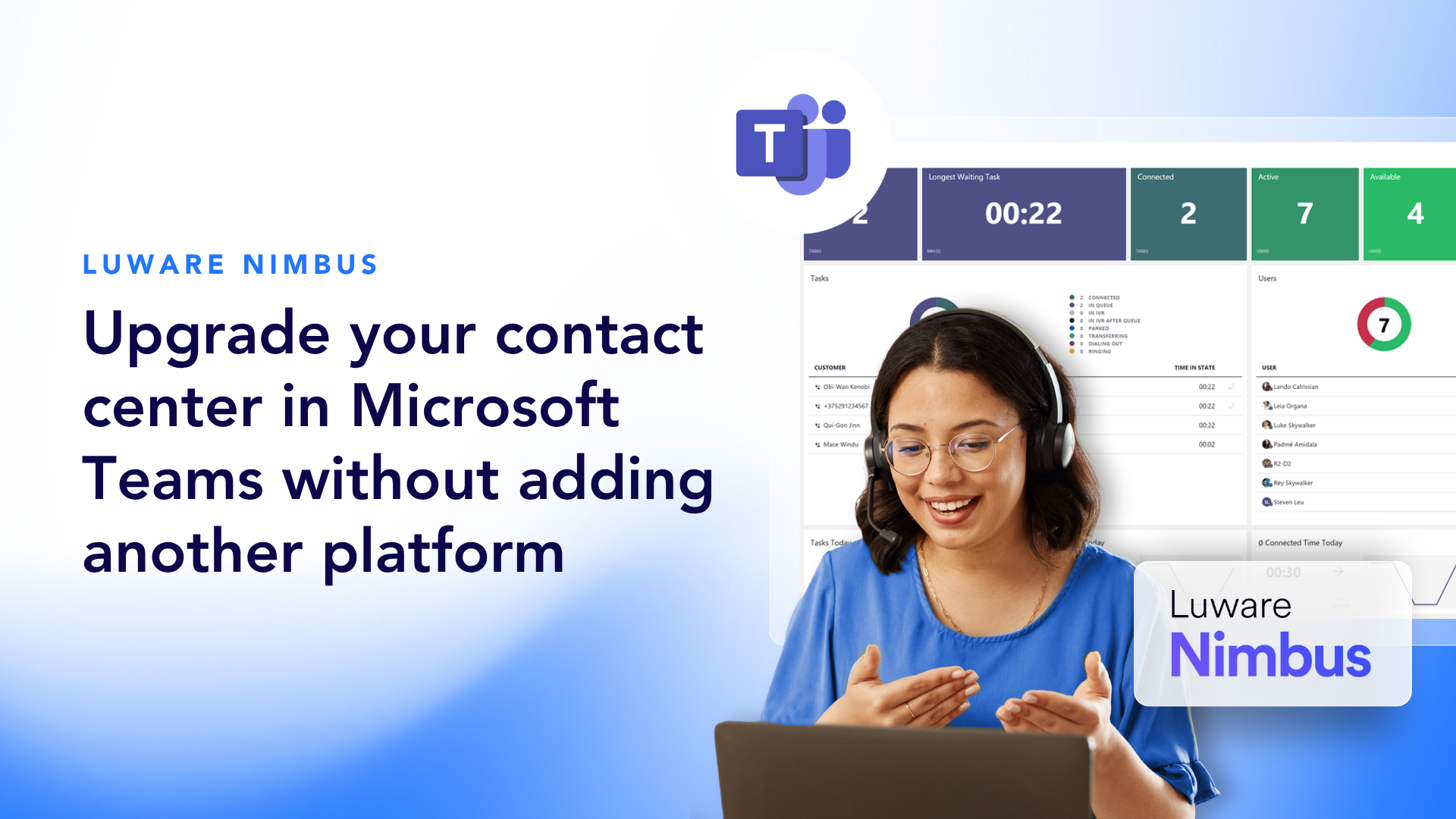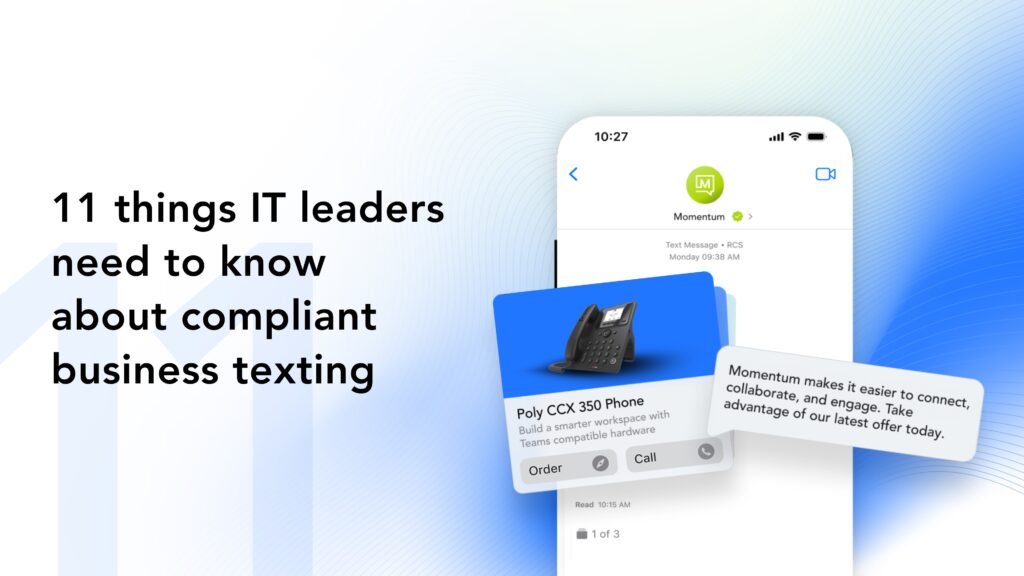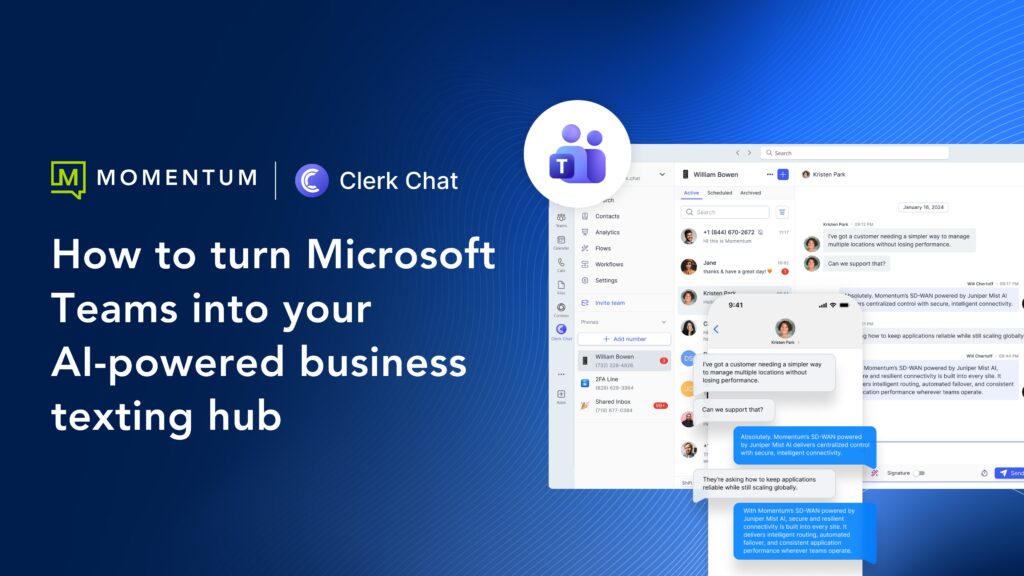Running a contact center today means balancing speed, visibility, and cost. But for many organizations, legacy systems are making that harder, not easier. You’ve invested in platforms and processes, but each new channel or escalation path adds more tools to manage—and more pressure on your agents to keep up.
Customers expect fast, personalized service. Supervisors need real-time insight. And your teams are often stuck switching between apps, managing clunky interfaces, or waiting on IT just to make small changes.
There’s a simpler way forward.
By extending Microsoft Teams with Luware (and deploying it with Momentum), you can modernize your contact center using the tools your team already knows. Routing, dashboards, automation, and omnichannel control all live inside Teams, giving you the performance of an enterprise platform without the complexity of one.

Let’s take a closer look at why traditional platforms are slowing contact centers down—and what you can do instead.
Why legacy contact centers are slowing you down
Most contact centers still run on infrastructure built for a different era, when phone queues were static, support was centralized, and digital channels were optional. These systems haven’t kept up with how customer service actually works today.
Every time a team launches a new product, opens a regional office, or responds to shifting demand, legacy platforms introduce delays and complexity.
Routing logic is hard-coded. Visibility is limited. Workflow changes require IT support or third-party involvement. What should take hours takes weeks.
And the cracks show everywhere:
- Agents juggle multiple logins, slowing down response time
- Supervisors rely on outdated or incomplete dashboards
- Queue changes, campaign setups, or escalation rules require back-end work
- Integrations with CRMs, ticketing tools, or analytics platforms are costly or unreliable
These systems may still function, but they’re built on outdated assumptions. And they weren’t designed for distributed teams, real-time visibility, or omnichannel service.
After all, a platform that doesn’t evolve with your CX needs slows down your teams, increases support costs, and limits your ability to adapt.
Related Content: 5 signs it’s time to move your contact center to Microsoft Teams
How Microsoft Teams + Luware enables modern customer experiences
Luware Nimbus turns Microsoft Teams into a fully operational contact center, built for the pace, visibility, and flexibility today’s service teams need.
Rather than layering on more tools, Luware extends what Teams already does well, giving your agents and supervisors the capabilities they’ve been missing.
Because it’s built natively inside Microsoft 365, there’s no context-switching, retraining, or disconnected reporting systems to manage. Everything lives where your team already works.
With Teams + Luware, you can:
- Route calls dynamically using skills, presence, SLAs, or custom logic
- Monitor queues in real time and analyze trends across departments
- Surface CRM or ticketing context during live interactions
- Engage across voice, video, and chat, all inside Teams
- Automate triage and follow-up with Power Automate triggers
- Use AI tools like Copilot to support agents mid-call and post-interaction
This native, extensible foundation helps you simplify operations, reduce ramp-up time, and scale support without stacking systems.
Learn how to modernize your contact center with Microsoft Teams in our guide to future-proofing your CX strategy.
Native Teams call handling: Before and after Luware
It’s not always obvious how much time and clarity your team loses to disconnected systems until you see the difference. Luware transforms Microsoft Teams into a centralized, responsive call handling platform that reduces friction at every level.
Here’s how the shift compares:
| Capability | Legacy Platforms | Teams + Luware |
|---|---|---|
| Platform navigation | Disjointed tools and separate logins | All functionality unified inside Teams |
| Call routing | Manual, fixed rules | Dynamic routing based on presence and logic |
| Agent onboarding | Multi-day setup and tool switching | Quick setup inside the platform they already use |
| Supervisor dashboards | Limited real-time insights | Live dashboards with queue and agent views |
| Automation & AI | Requires third-party tools | Built-in with Power Automate and Copilot |
| CRM integration | Costly or limited | Native integration with Microsoft and others |
| Scalability | Rigid infrastructure and high overhead | Modular and flexible across teams and sites |
Capabilities
Platform navigation
Legacy Platforms: Disjointed tools and separate logins
Teams + Luware: All functionality unified inside Teams
Call routing
Legacy Platforms: Manual, fixed rules
Teams + Luware: Dynamic routing based on presence and logic
Agent onboarding
Legacy Platforms: Multi-day setup and tool switching
Teams + Luware: Quick setup inside the platform they already use
Supervisor dashboards
Legacy Platforms: Limited real-time insights
Teams + Luware: Live dashboards with queue and agent views
Automation & AI
Legacy Platforms: Requires third-party tools
Teams + Luware: Built-in with Power Automate and Copilot
CRM integration
Legacy Platforms: Costly or limited
Teams + Luware: Native integration with Microsoft and others
Scalability
Legacy Platforms: Rigid infrastructure and high overhead
Teams + Luware: Modular and flexible across teams and sites
By consolidating routing, visibility, and workflow automation into a single platform, your contact center will have a modern foundation without needing to start from scratch.
Real-world use cases of a native Teams contact center
Whether you’re managing high volumes, sensitive data, or geographically distributed teams, a Teams native contact center adapts to the way your organization works without requiring heavy customization or disconnected tools.
Here’s how organizations in key industries are using it every day:
Healthcare
In a busy regional clinic network, call routing demands both efficiency and care. Using a Teams native contact center allows staff to route calls based on department, urgency, and time of day.
Scheduling requests, nurse line triage, and specialist transfers all follow skill-based logic that factors in presence and queue status. Staff see relevant patient info as soon as the call arrives, and supervisors can monitor patterns in real time to shift resources on the fly.
Result: Shorter wait times, smoother handoffs, and less time spent searching for the right contact without compromising compliance or security.
Financial services
In financial services, customer service teams need to balance responsiveness with precision.
Calls can be routed by client tier, location, or service type, prioritizing high-value accounts and connecting them with the right advisor the first time.
CRM data surfaces automatically inside Teams, giving agents full context without switching tools. Meanwhile, call data is logged automatically for compliance, and follow-up workflows are triggered with Power Automate.
Result: Advisors stay focused on client needs, while routing, compliance, and performance tracking run quietly in the background.
Retail and e-commerce
For retailers, speed and scale are everything, especially during seasonal peaks.
A Teams-based contact center allows teams to route calls based on issue type, region, or time of day.
Agents can prioritize fulfillment, billing, or product questions in real time. During high-volume periods, automated call flows and queue logic adjust dynamically based on staffing and demand. Routine follow-ups, like tracking updates or refund confirmations, are handled automatically.
Result: Fewer delays, less manual work, and consistent service across stores and support teams.
Public sector
Public agencies often manage dozens of services through one central contact point. With a Luware-powered Teams contact center, calls route by department and language preference, and accessibility needs are flagged automatically for priority handling.
Supervisors manage queues and workloads from a live dashboard and can adjust routing rules without technical support. All interactions are logged for transparency and compliance.
Result: Citizens reach the right department faster, staff manage queues more confidently, and the agency gains clearer oversight across teams.
Each of these organizations began with a need to simplify call handling, ultimately resulting in a more agile and responsive support system tailored to their existing workflows.
Build your AI and automation strategy inside Microsoft Teams
Most contact centers talk about AI and automation. But without the right foundation, adding it means stitching together third-party tools, writing custom integrations, or handing everything over to IT.
When your contact center is already inside Microsoft Teams, that work is largely done.
With native access to Power Automate, adaptive cards, and tools like Copilot, you can start building intelligent workflows that save time and reduce effort without any external platforms.
Here’s what that looks like in practice:
- Capture caller intent before routing using adaptive prompts
- Trigger backend workflows based on call type, queue, or duration
- Summarize conversations in real time with Copilot and send outcomes to CRM
- Set SLA timers and automate escalation paths for high-priority queues
- Automatically launch surveys or create support cases in Dynamics, Salesforce, or other systems
This kind of intelligent routing and follow-up doesn’t just speed things up. It reduces the chance of error, lowers agent workload, and helps teams deliver more consistent experiences, especially under pressure.
And because it’s built on Microsoft 365, you’re not locked into a rigid set of automations. You can test, iterate, and expand as your business needs change.
Want to see what AI-powered productivity actually looks like inside Teams? Explore real examples and practical workflows in our guide to supercharging productivity with AI in Microsoft Teams.
Find the right deployment path for your team
Not every contact center starts from the same place.
Some teams are migrating from legacy phone systems. Others are already deep into Microsoft Teams but still juggling third-party routing tools.
The strength of building your contact center natively inside Teams is that there’s no one-size-fits-all rollout. You can deploy based on what works best for your organization.
Here are some of the common paths we see:
- Start with inbound voice routing for one team: Many organizations begin by modernizing a single support or service queue, often where dropped calls or misrouted tickets are most common.
- Add internal queues for HR, IT, or scheduling: With native Teams presence and visibility, even non-customer-facing teams benefit from structured routing and performance tracking.
- Extend to chat and video once voice is solid: Because omnichannel support runs through the same platform, there’s no need to stand up separate systems when you’re ready to scale.
- Integrate with CRM or scheduling tools when the time is right: The platform supports connections with Dynamics, Salesforce, and others. There’s no rip-and-replace required.
- Duplicate workflows across offices or regions: Once a routing flow is working for one team, it’s easy to replicate and adapt it across locations or service lines.
This approach gives you control without slowing down progress. You build for what’s needed today without boxing yourself in tomorrow.
Build a future-proofed contact center with a partner who knows Teams
Modernizing your contact center doesn’t have to mean ripping out systems or taking on a massive migration.
But staying stuck with legacy tools that slow down your agents, limit visibility, and block automation comes at a cost, from missed calls and frustrated customers to teams working harder than they should.
A Teams-native contact center gives you the routing, reporting, and responsiveness you need inside a platform your team already uses. And with Momentum as your deployment partner, you don’t just get the technology. You get expert-led onboarding, purpose-built workflows, and a faster path to value.
Whether you’re replacing a legacy system or scaling support across departments, Momentum helps you do it without the usual delays, tickets, or complexity.
Ready to see how you can deploy a modern contact center natively in Teams? Talk to Momentum to explore your options.
Frequently asked questions when upgrading to Teams + Luware
How is Luware different from Teams’ built-in call queues?
Luware adds advanced features like SLA routing, real-time dashboards, CRM integration, automation, and visibility into queue performance, all directly inside Teams.
Can I fully replace platforms like Genesys, Avaya, or Cisco?
Yes. Many Momentum customers have migrated from legacy platforms to Luware with improved performance, stronger analytics, and lower total cost of ownership.
How long does it take to deploy?
Initial setup can be completed in under 30 minutes. Most full deployments are completed far faster than with traditional platforms, depending on your complexity.
Will this work for my hybrid or remote agents?
Yes. Because it’s built inside Teams, agents can work from anywhere. There are no special VPNs, logins, or desktop installs required.
What happens after go-live?
Momentum provides ongoing support, training, optimization, and guidance on scaling your solution as your business grows.
Ready to rethink your contact center?
You don’t have to choose between outdated legacy tools or complex migrations. With Momentum, Microsoft Teams, and Luware, you can modernize on your terms—using the tools your team already knows and the platform your business already trusts.



